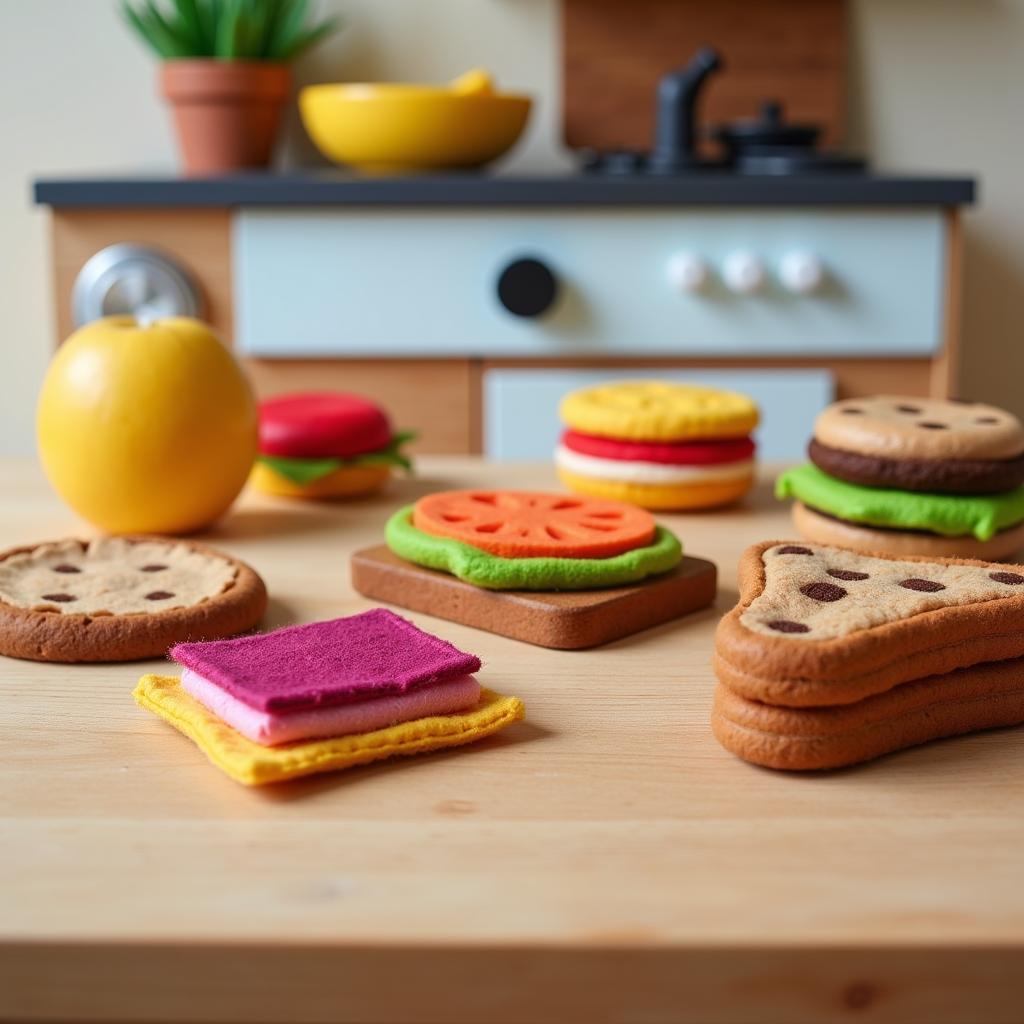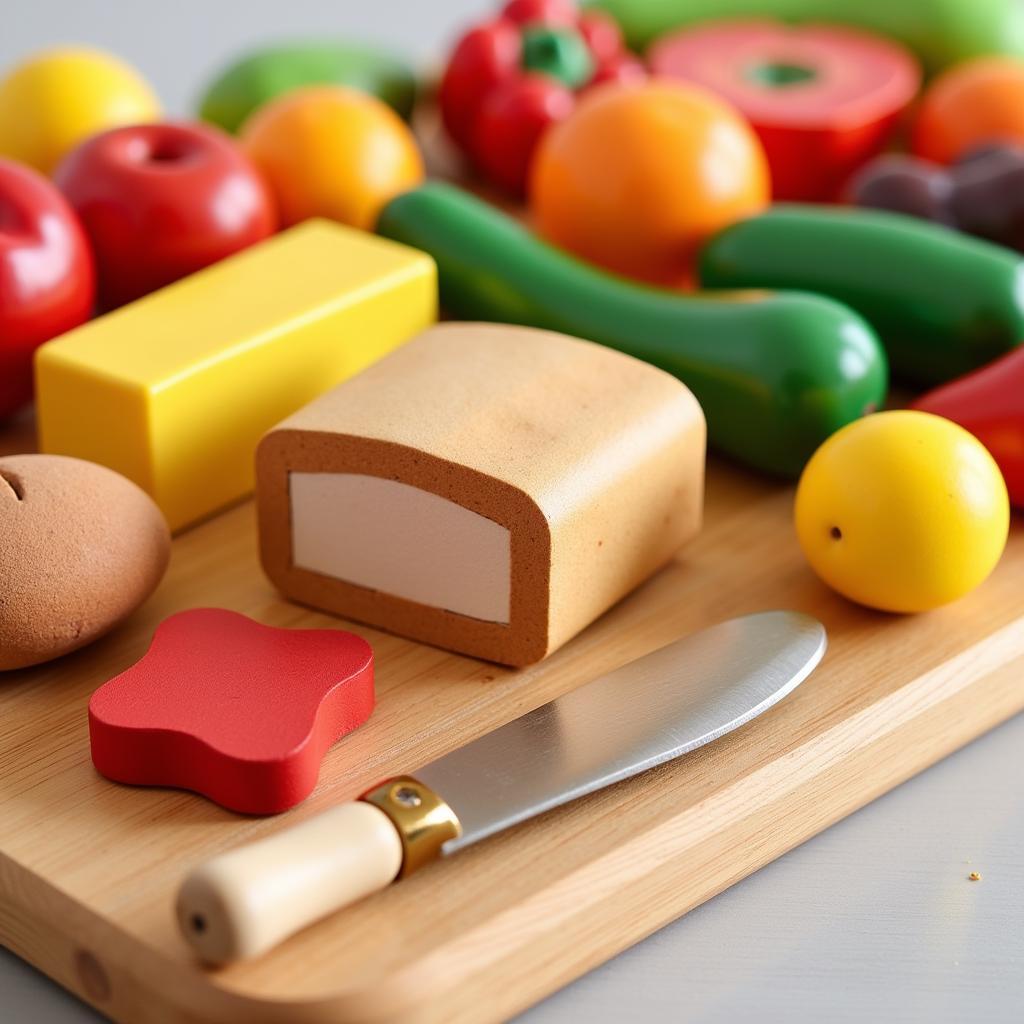Food For Play Kitchens isn’t just about miniature plastic ingredients; it’s about sparking imagination and creativity in young chefs. Whether your little one is whipping up imaginary feasts or hosting teddy bear tea parties, the right “ingredients” can take their play to the next level.
Let’s dive into some exciting ideas for food for play kitchens that will have your child saying “Bon Appetit!” in no time.
Beyond the Basics: Engaging Food for Play Kitchen
While classic plastic food sets have their charm, incorporating a variety of textures, colors, and materials can enrich the play experience.
-
Natural Wonders: Think wooden fruits and vegetables, felt pizza toppings, or even real beans and rice (safely contained, of course!). These items offer a tactile experience that plastic simply can’t replicate.
-
DIY Delights: Get crafty! Create salt dough cookies, sew felt sandwiches, or paint cardboard milk cartons. These personalized creations add a special touch to any play kitchen.
 DIY Felt Food
DIY Felt Food
- Sensory Sensations: Don’t be afraid to get messy! Introduce play dough for molding pastries, kinetic sand for building pretend cakes, or even cooked spaghetti for a tactile and fun “sensory soup”.
Bringing Play Food to Life: Tips for Engaging Play
The key to maximizing the fun of food for play kitchens is to encourage imaginative play. Here are some ideas to get you started:
-
Set the Scene: Create a thematic backdrop for your child’s culinary adventures. It could be a bustling restaurant, a cozy bakery, or even a tropical smoothie bar!
-
Role Play Fun: Encourage your child to take on different roles, like chef, server, or customer. This fosters social and language skills while adding depth to their play.
-
Story Time Cooking: Weave storytelling into the mix! Invent narratives around the food they prepare. “The princess needs a birthday cake!” or “The hungry dinosaur wants a leafy lunch!”.
 Play Kitchen Restaurant
Play Kitchen Restaurant
- Real-Life Inspiration: Incorporate elements from your own kitchen. Let your child help you measure ingredients while you bake, or have them “wash dishes” alongside you.
Choosing the Perfect Food for Play Kitchen: Factors to Consider
With so many options available, it can be overwhelming to choose the best food for your child’s play kitchen. Here are a few factors to keep in mind:
-
Safety First: Always prioritize safety. Ensure toys are age-appropriate, free from choking hazards, and made with non-toxic materials.
-
Durability: Play kitchens see a lot of action! Opt for durable materials that can withstand enthusiastic play.
-
Educational Value: Look for toys that encourage learning through play, such as food sets that promote color recognition, counting, or sorting skills.
 Wooden Play Food Set
Wooden Play Food Set
- Easy to Clean: Let’s face it, play kitchens can get messy. Choose materials that are easy to wipe down or wash.
Food for Play Kitchen: Nourishing Imagination and Creativity
Food for play kitchens is more than just toys; it’s a gateway to a world of imagination, creativity, and fun. By providing a variety of engaging and stimulating “ingredients,” you can empower your child to create their own culinary masterpieces and embark on endless culinary adventures.
Remember, the most important ingredient in any play kitchen is a dash of imagination and a whole lot of fun!
FAQs About Food for Play Kitchen
1. What age is appropriate for play kitchens?
Play kitchens are suitable for a wide range of ages. Simple sets are great for toddlers, while more elaborate kitchens can engage preschoolers and beyond.
2. Are there food for play kitchen options for specific dietary restrictions?
Yes! You can find play food sets representing various cuisines and dietary preferences. You can also find companies that create custom felt food to match specific dietary needs.
3. Can I make my own food for play kitchen?
Absolutely! DIY play food is a fun and creative activity. Salt dough, felt, and cardboard are great materials to get you started.
4. Where can I find realistic-looking food for play kitchen?
Many toy stores and online retailers offer realistic-looking play food made from wood, plastic, or fabric.
5. What are some creative ways to store food for play kitchen?
Baskets, bins, and clear containers work well. You can also use a pegboard to hang pots, pans, and utensils.
Looking for more culinary inspiration? Check out these other articles:
- Food trucks for sale Boston: Explore the exciting world of mobile kitchens!
- Non food birthday treats for school: Celebrate birthdays with creative, non-food alternatives.
- Cellophane food bags: Discover versatile packaging solutions for treats and gifts.
Need help finding the perfect food for play kitchen?
Contact us!
- Phone: 02437655121
- Email: minacones@gmail.com
- Visit us: 3PGH+8R9, ĐT70A, thôn Trung, Bắc Từ Liêm, Hà Nội, Việt Nam
Our team is here to help 24/7!